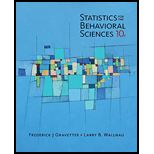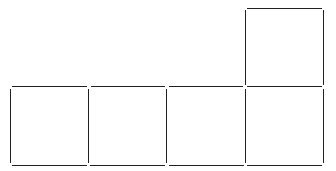
Concept explainers
In a classic study in the area of problem solving, Katona (1940) compared the effectiveness of two methods of instruction. One group of participants was shown the exact. step-by-step procedure for solving a problem and was required to memorize the solution. Participants in a second group were encouraged to study the problem and find the solution on their own. They were given helpful hints and clues, but the exact solution was never explained. The study included the problem in the following figure showing a pattern of five squares made of matchsticks. The problem is to change the pattern into exactly four squares by moving only three matches. (All matches must be used. none can be removed, and all the squares must be the same size.) After 3 weeks, both groups returned to be tested again. The two groups did equally well on the matchstick problem they had learned earlier. But when they were given new problems (similar to the match- stick problem), the memorization group had much lower scores than the group who explored and found the solution on their own. The following data demonstrate this result.
| Memorization of the Solution | Find a Solution Your Own |
Incidentally, if you still have not discovered the solution to the matchstick problem, keep trying. According to Katona’s results, it would be very poor teaching strategy for us to give you the answer. If you still have not discovered the solution, however, check Appendix C at the beginning of the problem solutions for Chapter 10 and we will show you how it is done.
a. Is there a significant difference in performance on new problems for these two groups? Use a two- (ailed test with
b. Construct a 90% confidence
n=8
We need to find there is any significant difference in the two populations or not also find the confidence interval for the mean difference at 95% confidence interval.
Answer to Problem 15P
Solution:
- There is significant difference of the means of two groups
Explanation of Solution
We have provided with two samples with along with summary statistic of each sample. For the significance difference of the two sample mean will follow two sample t-test on the basis of the sample will construct critical point. Then will calculate r2 measure statistic that will give us the effect size measure. Then will conclude the measures will imply what.
Given:
We have provided two samples with summary statistic
For first sample,
For second sample,
Formula used:
For one sample of size n, we have below formulas
Mean=
SS=
Variance=
If there are two samples of sizes n1and n2 we have the following formula for pooled SD,
Sp=Pooled Variance
S12=sample variance of first sample
S22=sample variance of second sample
Denoting,
Se=standard error of the mean,
For the confidence interval at 95% level is,
Consider,
The t-distribution with df (n1+n2-2) =14
Hence the CI is,
Calculation:
a)
Here will proceed by the steps as,
Then will construct hypothesis as,
H0: there is no difference in means of two groups
Vs.
H1: not H0
Test statistic is
Calculation of the test statistic is,
Critical point at 90% confidence of t-statistic of df (n1+n2-2) = 14 is 1.76
Since,
|T| > 1.76 we reject H0 and can comment that there is significant difference in the mean calories of these two groups.
b)
Now the confidence interval is,
D=10.5-6.16=4.34
Conclusion:
We may conclude that there is significant difference of the means of these two groups also there is moderately high effect means. Also zero does not in the CI so that we have rejected H0: hence we can say that there is significant difference in the means of these two groups.

Want to see more full solutions like this?
Chapter 10 Solutions
Statistics for The Behavioral Sciences (MindTap Course List)
- You find out that the dietary scale you use each day is off by a factor of 2 ounces (over — at least that’s what you say!). The margin of error for your scale was plus or minus 0.5 ounces before you found this out. What’s the margin of error now?arrow_forwardSuppose that Sue and Bill each make a confidence interval out of the same data set, but Sue wants a confidence level of 80 percent compared to Bill’s 90 percent. How do their margins of error compare?arrow_forwardSuppose that you conduct a study twice, and the second time you use four times as many people as you did the first time. How does the change affect your margin of error? (Assume the other components remain constant.)arrow_forward
- Out of a sample of 200 babysitters, 70 percent are girls, and 30 percent are guys. What’s the margin of error for the percentage of female babysitters? Assume 95 percent confidence.What’s the margin of error for the percentage of male babysitters? Assume 95 percent confidence.arrow_forwardYou sample 100 fish in Pond A at the fish hatchery and find that they average 5.5 inches with a standard deviation of 1 inch. Your sample of 100 fish from Pond B has the same mean, but the standard deviation is 2 inches. How do the margins of error compare? (Assume the confidence levels are the same.)arrow_forwardA survey of 1,000 dental patients produces 450 people who floss their teeth adequately. What’s the margin of error for this result? Assume 90 percent confidence.arrow_forward
- The annual aggregate claim amount of an insurer follows a compound Poisson distribution with parameter 1,000. Individual claim amounts follow a Gamma distribution with shape parameter a = 750 and rate parameter λ = 0.25. 1. Generate 20,000 simulated aggregate claim values for the insurer, using a random number generator seed of 955.Display the first five simulated claim values in your answer script using the R function head(). 2. Plot the empirical density function of the simulated aggregate claim values from Question 1, setting the x-axis range from 2,600,000 to 3,300,000 and the y-axis range from 0 to 0.0000045. 3. Suggest a suitable distribution, including its parameters, that approximates the simulated aggregate claim values from Question 1. 4. Generate 20,000 values from your suggested distribution in Question 3 using a random number generator seed of 955. Use the R function head() to display the first five generated values in your answer script. 5. Plot the empirical density…arrow_forwardFind binomial probability if: x = 8, n = 10, p = 0.7 x= 3, n=5, p = 0.3 x = 4, n=7, p = 0.6 Quality Control: A factory produces light bulbs with a 2% defect rate. If a random sample of 20 bulbs is tested, what is the probability that exactly 2 bulbs are defective? (hint: p=2% or 0.02; x =2, n=20; use the same logic for the following problems) Marketing Campaign: A marketing company sends out 1,000 promotional emails. The probability of any email being opened is 0.15. What is the probability that exactly 150 emails will be opened? (hint: total emails or n=1000, x =150) Customer Satisfaction: A survey shows that 70% of customers are satisfied with a new product. Out of 10 randomly selected customers, what is the probability that at least 8 are satisfied? (hint: One of the keyword in this question is “at least 8”, it is not “exactly 8”, the correct formula for this should be = 1- (binom.dist(7, 10, 0.7, TRUE)). The part in the princess will give you the probability of seven and less than…arrow_forwardplease answer these questionsarrow_forward
- Selon une économiste d’une société financière, les dépenses moyennes pour « meubles et appareils de maison » ont été moins importantes pour les ménages de la région de Montréal, que celles de la région de Québec. Un échantillon aléatoire de 14 ménages pour la région de Montréal et de 16 ménages pour la région Québec est tiré et donne les données suivantes, en ce qui a trait aux dépenses pour ce secteur d’activité économique. On suppose que les données de chaque population sont distribuées selon une loi normale. Nous sommes intéressé à connaitre si les variances des populations sont égales.a) Faites le test d’hypothèse sur deux variances approprié au seuil de signification de 1 %. Inclure les informations suivantes : i. Hypothèse / Identification des populationsii. Valeur(s) critique(s) de Fiii. Règle de décisioniv. Valeur du rapport Fv. Décision et conclusion b) A partir des résultats obtenus en a), est-ce que l’hypothèse d’égalité des variances pour cette…arrow_forwardAccording to an economist from a financial company, the average expenditures on "furniture and household appliances" have been lower for households in the Montreal area than those in the Quebec region. A random sample of 14 households from the Montreal region and 16 households from the Quebec region was taken, providing the following data regarding expenditures in this economic sector. It is assumed that the data from each population are distributed normally. We are interested in knowing if the variances of the populations are equal. a) Perform the appropriate hypothesis test on two variances at a significance level of 1%. Include the following information: i. Hypothesis / Identification of populations ii. Critical F-value(s) iii. Decision rule iv. F-ratio value v. Decision and conclusion b) Based on the results obtained in a), is the hypothesis of equal variances for this socio-economic characteristic measured in these two populations upheld? c) Based on the results obtained in a),…arrow_forwardA major company in the Montreal area, offering a range of engineering services from project preparation to construction execution, and industrial project management, wants to ensure that the individuals who are responsible for project cost estimation and bid preparation demonstrate a certain uniformity in their estimates. The head of civil engineering and municipal services decided to structure an experimental plan to detect if there could be significant differences in project evaluation. Seven projects were selected, each of which had to be evaluated by each of the two estimators, with the order of the projects submitted being random. The obtained estimates are presented in the table below. a) Complete the table above by calculating: i. The differences (A-B) ii. The sum of the differences iii. The mean of the differences iv. The standard deviation of the differences b) What is the value of the t-statistic? c) What is the critical t-value for this test at a significance level of 1%?…arrow_forward
 Algebra: Structure And Method, Book 1AlgebraISBN:9780395977224Author:Richard G. Brown, Mary P. Dolciani, Robert H. Sorgenfrey, William L. ColePublisher:McDougal Littell
Algebra: Structure And Method, Book 1AlgebraISBN:9780395977224Author:Richard G. Brown, Mary P. Dolciani, Robert H. Sorgenfrey, William L. ColePublisher:McDougal Littell Intermediate AlgebraAlgebraISBN:9781285195728Author:Jerome E. Kaufmann, Karen L. SchwittersPublisher:Cengage Learning
Intermediate AlgebraAlgebraISBN:9781285195728Author:Jerome E. Kaufmann, Karen L. SchwittersPublisher:Cengage Learning Algebra for College StudentsAlgebraISBN:9781285195780Author:Jerome E. Kaufmann, Karen L. SchwittersPublisher:Cengage Learning
Algebra for College StudentsAlgebraISBN:9781285195780Author:Jerome E. Kaufmann, Karen L. SchwittersPublisher:Cengage Learning


